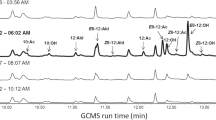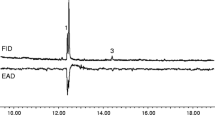Abstract
The leaf-eating caterpillar, Opisina arenosella Walker, is the most destructive pest of coconut palm in India and Southeast Asia. The management practices employed against O. arenosella so far have been unsuccessful in many instances in India, due to the pest behaviour and coconut palm phenology. The life cycle, incidence and behaviour of O. arenosella are rather interesting and useful for the intervention of pheromone trapping technique for its management. We conducted the present study with the intention of identifying the female sex pheromone of O. arenosella and testing its efficacy under field conditions. Gas chromatography coupled electroantennographic detection (GC–EAD) and gas chromatography–mass spectrometry (GC–MS) analysis of female pheromone glands extract of one-day-old O. arenosella females confirmed the presence of (Z,Z,Z)- 3,6,9-tricosatriene (Z3Z6Z9-23Hy) as the dominant sex pheromone component. The male antennal response to female pheromone gland extract and synthetic Z3Z6Z9-23Hy was recorded using GC–EAD, and the results revealed that antennal response was positive to both the treatments at 0.13 mV and 0.14 mV respectively, compared to control (air), which was 0.016 mV. It was also evident from wind-tunnel experiments that the male moth response was high (80%) with the female gland extract, compared to 60% with synthetic pheromone and 0% for control (air). Male moths caught in the traps with and without lure were assessed in two field sites and recorded 69.26% and 54.25% more moth catches in the traps with the lure.We also observed a similar result in the cage experiment in which male moths caught in the traps with and without lure were 64.50% and 12.40%, respectively. The study also confirmed that 93.20% moths caught in the pheromone-baited traps were male. From the study, it is evident that the presence of (Z,Z,Z)-3,6,9-tricosatriene, which is the sex pheromone compound from the female gland extract of O. arenosella, is an effective attractant in pheromone traps for the male moth under field conditions.
Similar content being viewed by others
References
Allison J. D. and Cardé R. T. (eds) (2016) Pheromone Communication in Moths: Evolution, Behavior, and Application. University of California Press, Oakland, CA. 416 pp.
Ambrogi B. G., Fonseca M. G., Coracini M. D. A. and Zarbin P. H. G. (2009) Calling behaviour and male response towards sex pheromone of poplar moth Con-dylorrhiza vestigialis (Lepidoptera: Crambidae). Journal of Pest Science 82, 55–60.
Ando T., Inomata S. and Yamamoto M. (2004) Lepidop-teran sex pheromone. Current Chemistry 239, 51–96.
Arn H., Toth M. and Priesner E. (2000) List of sex pheromones of female Lepidoptera and related male attractants. IOBC, WRPS, Montfavet, France. Internet ed. https://doi.org/nysaes.cornell.edu/pheronet.
Cabrera A., Eiras A. E., Gries G., Gries R., Urdaneta N., Miras B., Badji C. and Jaffe K. (2001) Sex pheromone of tomato fruit borer, Neoleucinodes elegantalis. Journal of Chemical Ecology 27, 2097–2107.
Carde R. T. (1976) Utilization of pheromones in the population management of moth pests. Environmental Health Perspectives 14, 133–144.
Chandrashekharaiah M., Chakravarthy A. K., Bhanu K. R. M. and Prabhakar M. S. (2014) Studies on feld biology of Opisina arenosella Walker: A key parameter of mass trapping. Uttar Pradesh Journal of Zoology 34, 129–135.
Cork A. and Hall D.R. (1998) Application of pheromones for crop pest management in the Indian sub-continent. Journal of Asia-Pacific Entomology 1, 35–49.
El-Sayed A.(2014) The Pherobase: Database of Insect Pheromones and Semiochemicals. https://doi.org/www.pherobase.com.
Fernando L. C. R. and Chandrasirl K. A. S. (1997) More evidence on the attraction of males to the female sex pheromone of Opisina arenosella Walker. Cocos 12, 79–81.
Gaude Priolkar P. P., Wadkar S. S. and Kshirsagar P. J. (2017) Comparative economics of tender nuts and matured nuts of coconut in Ratnagiri district (M.S.). Contemporary Research in India 7, 281–287.
Gillespie D. R., King G. G. S., Salasreyes V. A. and Slessor K. N. (1984) Determination of the sex pheromone components of Cheimophila salicella (Lepidoptera, Oe-cophoridae), a pest of blueberry in British Columbia. Canadian Entomologist 116, 1397–1402.
Heikkila M., Mutanen M., Kekkonen M. and Kaila L. (2014) Morphology reinforces proposed molecular phylogenetic affnities: A revised classification for Gelechioidea (Lepidoptera). Cladistics 30, 563–589.
Hoddle M. S., Millar J. G., Hoddle C. D., Zou Y., McElfresh J. S. and Lesch S. M. (2011) Field optimization of the sex pheromone of Stenoma catenifer (Lepidoptera: Elachistidae): evaluation of lure types, trap height, male fight distances, and number of traps needed per avocado orchard for detection. Bulletin of Entomological Research 101, 145–152.
Joy P. J. and Joseph K. J. (1972) Incidence of Nephantis serinopa Meyrick in Badagara area (Kerala State): Its past history and future prospects for control. Coconut Bulletin 2, 2–5.
Kanagaratnam P. and Pinto J. L. J. G. (1985) Effect of monocrotophos on the leaf eating caterpillar, Opisina arenosella Walker, when injected into the trunk of the coconut palm. Cocos 3, 9–15.
Kumara A. D. N. T., Chandrashekharaiah M., Subaharan K. and Chakravarthy A. K. (2015) Periodicity of adult emergence and sexual behavior of coconut black headed caterpillar, Opisina arenosella Walker (Lepidoptera: Oecophoridae). Phytoparasitica 43, 701–712.
Linn C. E. Jr, Campbell M.G. and Roelofs W. L. (1986) Male moth sensitivity to multicomponent pheromones: Critical role of female-released blend in determining the functional role of components and active space of the pheromone. Journal of Chemical Ecology 12, 659–668.
Lofstedt C., Wahlberg N. and Millar J. M. (2016) Evolutionary patterns of pheromone diversity in Lepid-optera, pp. 43–78. In Pheromone Communication in Moths: Evolution, Behavior and Application (edited by J. D. Allison and R. T. Cardé). University of California Press, Oakland, CA.
Mohan C., Radhakrishnan Nair C. P., Kesavan Nam-poothiri C. and Rajan P. (2010) Leaf-eating caterpillar (Opisina arenosella)-induced yield loss in coconut palm. International Journal of Tropical Insect Science 30, 132–137.
Mumford J. D., Hall D. R., Perera P. A. C. R. and Kanagaratnam P. (1986) Annual Report of the Crop Protection Division. Coconut Research Institute, Sri Lanka.
Muralimohan K., Sreekanth P. N. and Srinivasa Y. B.(2007) Light traps for managing the coconut black headed caterpillar. Pest Management in Horticultural Ecosystems 13, 159–164.
Murthy K. S., Gour T. B., Reddy D. D. R., Babu T. R. and Zaheruddcen S. M.(1995) Pheromone baits for coconut black headed caterpillar, Opisina arenosella Walker. Insect Environment 1, 3–4.
Nagarkatti S. (1973) Biological control campaign against Nephantis serinopa Meyrick in India in the light of modern concepts. Journal of Plantation Crops 1, 28–31.
Nasser M. and Abdurahiman U. C. (2001) Biological control of the coconut caterpillar Opisina arenosella (Lepidoptera: Xylorictidae): Achievements and prospects, pp. 285–305. In Biocontrol Potential and Its Exploitation in Sustainable Agriculture (edited by R.K. Up-adhyay, K.G. Mukerji and B.P. Chamola). Kluwer Academic/Plenum Publishers, New York.
Nirula K. K. (1956) Investigations on the pests of coconut palm part III, Nephantis serinopa Meyrick. Indian Coconut Journal 9, 101–131.
Roelofs W. L. and Bjostad L. B. (1984) Biosynthesis of lepidopteran pheromones. Bioorganic Chemistry 12, 279–298.
Rothschild G. H. L. and Minks A. K. (1977) Some factors infuencing the performance of pheromone traps for oriental fruit moth in Australia. Entomologia Experimentalis et Applicata 22, 171–182.
Shivashankar T., Annadurai R. S. and Srinivas M. (2000) Control of coconut black-headed caterpillar (Opisina arenosella Walker) by systemic application of Soluneem—a new water-soluble neem insecticide formulation. Current Science 78, 176–179.
Simmonds F. J. (1970) Biological control of pests. Tropical Science 12, 191–201.
Srinivasa Y. B. and Muralimohan K. (2009) Scope for managing age-structured populations of the coconut black headed caterpillar, Opisina arenosella (Walker) using sex pheromones. Pest Management in Horticultural Ecosystems 15, 89–92.
Sumathi C. (2000) Studies on the sex pheromone of the pine looper moth, Bupalus piniaria L. (Lepidoptera: Geometridae). PhD thesis, University of Greenwich, UK.
Twidle A. M., Clare G. K., Stanbury M.E. and El-Sayed A.M. (2014) Sex attractant for Izatha peroneanella (Walker) (Lepidoptera: Oecophoridae sensu lato), a lichen tuft moth. New Zealand Entomologist 37, 93–95.
Wallis D. R. and Shaw P. W. (2008) Evaluation of coloured sticky traps for monitoring beneficial insects in apple orchards. New Zealand Plant Protection 61, 328–332.
Witzgall P., Chambon J. P., Bengtsson M., Unelius C. R., Appelgren M., Makranczy G., Muraleedharan N., Reed D. W., Hellrigl K., Buser H. R., Hallberg E., Bergström G., Tóth M., Lofsted C. and Lofqvist J. (1996) Sex pheromones and attractants in the Eucosmini and Grapholitini (Lepidoptera, Tortricidae). Chemoecology 7, 13–23.
Witzgall P., Kirsch P. and Cork A. (2010) Sex pheromones and their impact on pest management. Journal of Chemical Ecology 36, 80–100.
Xiao W. and Honda H. (2010) Non-polar body waxes enhance sex pheromone activity in the yellow peach moth, Conogethes punctiferalis (Guenee) (Lepidoptera: Crambidae). Applied Entomology and Zoology 45, 449–456.
Yamakawa R., Takubo Y., Ohbayashi K., Naka H. and Ando T. (2012) Female sex pheromone of Cystidia couaggaria (Lepidoptera: Geometridae): Identification and feld attraction. Bioscience, Biotechnology, and Biochemistry 76, 1303–1307.
Author information
Authors and Affiliations
Corresponding author
Rights and permissions
About this article
Cite this article
Bhanu, K.R.M., Hall, D.R., Awalekar, R.V. et al. Identification and feld evaluation of female sex pheromone of leaf-eating caterpillar, Opisina arenosella (Lepidoptera: Oecophoridae). Int J Trop Insect Sci 38, 274–282 (2018). https://doi.org/10.1017/S1742758418000243
Accepted:
Published:
Issue Date:
DOI: https://doi.org/10.1017/S1742758418000243




